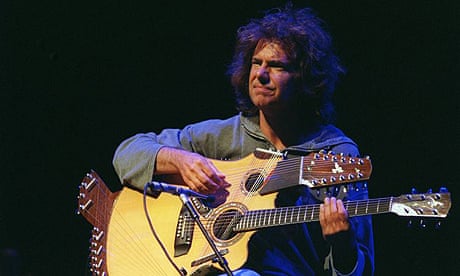Pat Metheny, the guitar star from Missouri, is one of the most commercially successful instrumentalists in jazz. But while such an achievement is not always regarded as a compliment, Metheny has never ditched jazz spontaneity just to please the crowd, winning him a wide auidence as well as reputation as a sophisticated and respected guitar improviser.
By the 1980s, Metheny albums hit six-figure sales, usually unthinkable in jazz. He toured the world every year in the 80s and 90s, filling rock venues with a mix of Latin grooves, pop hooks, jazz improv and electronics, and builing a repertoire of memorable original themes for audiences to burst into whoops of recognition at the first few notes of any of them. When he took his group on tour last year, with three of its four current members (Metheny, pianist Lyle Mays and bassist Steve Rodby), older fans tapped their toes to tunes they'd first heard as twentysomethings, while teenagers air-drummed percussionist Antonio Sanchez's fills and hits as if they'd somehow absorbed them from an earlier life.
Here's the track that turns audiences on more than any other, and defines the Metheny Group sound: Are You Going With Me? from 1981's Offramp.
Like Keith Jarrett, Metheny is that rare jazz musician who combines a pop-composer's instinct for an anthemic melody with a virtuoso ability to play extended spontaneous solos without repeating himself. Detractors have complained that some of the guitarist's hummable, soft-grooving fusion gets close to elevator music. But if the easygoing repertoire of the Pat Metheny Group has brought him worldwide fame outside of jazz circles, Metheny has also recorded cutting-edge music with free-jazz pioneer Ornette Coleman (Song X, in 1985), with minimalist composer Steve Reich (Different Trains, 1987), and free-improv British guitarist Derek Bailey (The Sign of Four, 1996), written Grammy-winning movie scores, and partnered post-bop stars including Herbie Hancock, Brad Mehldau and the late Michael Brecker. He has also found time to develop the one-man-band Orchestrion Machine – a stage-filling collection of robot percussion and keyboard instruments, self-strumming guitars and electronic effects that he would both co-ordinate and improvise with in the course of typically marathon-length performances.
Metheny was born in Lee's Summit, Missouri on 12 August 1954, and learned trumpet until the age of 14, when orthodontic treatment forced him to switch to guitar. In his second semester at the University of Miami, having already mastered the bebop-based guitar technique of the virtuoso Wes Montgomery, he was given a teaching job. Influenced by Montgomery and Ornette Coleman, but also by the Beatles, Metheny joined vibraphonist Gary Burton's proto jazz-rock group aged 19, then worked in a trio with bass guitar legend Jaco Pastorius and drummer Bob Moses. He formed the first version of the Pat Metheny Group in 1977 with former Miami alumni Mark Egan on bass and Danny Gottlieb on drums, and the Bill Evans-inspired pianist Lyle Mays, who became a lifetime collaborator and a powerful compositional influence.
From then on, the guitarist successfully balanced parallel lives – maintaining and developing the popular appeal of the Pat Metheny Group, while forming ad hoc partnerships with some of the most powerful improvisers in jazz, including fellow guitarists Jim Hall and John Scofield, saxophonists Michael Brecker and Joshua Redman, and many others. Metheny has also worked in small ensembles with bassists of the class of Charlie Haden, Dave Holland and Larry Grenadier, and in a flat-out post-bop trio with Holland and bop-drums veteran Roy Haynes. Perhaps one of the most intriguing apparent contradictions of his complex and restlessly curious musical sensibility is the devotion of this pop-savvy tunesmith to the impulsive and freewheeling music of Ornette Coleman, a revelation that hit the guitarist while still in his teens. More than any other, this might be the quality that has sustained his jazz-playing edge, and given his career such longevity and diversity.
Unlike those rock-influenced post-bop guitarists whose contribution has principally been to lend the jazz ensemble a soul, blues and r'n'b-influenced sound, Metheny has explored a lifelong fascination with technology (a quality he shares with a similarly broadminded innovator, Herbie Hancock) to give the jazz guitar many new textures, in particular the voice-like and sax-like sustained sounds made possible by digital-delay devices, the Roland guitar-synth and the Synclavier. He has also transformed acoustic ballad-playing through his devotion to the multi-stringed Pikasso harp-guitar. More than any other jazz guitarist of the post-bop era, Pat Metheny has given the instrument as natural and prominent a place in jazz as a trumpet or a saxophone.

Comments (…)
Sign in or create your Guardian account to join the discussion